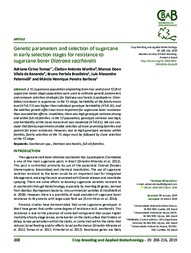Genetic parameters and selection of sugarcane in early selection stages for resistance to sugarcane borer Diatraea saccharalis.
Genetic parameters and selection of sugarcane in early selection stages for resistance to sugarcane borer Diatraea saccharalis.
Author(s): TOMAZ, A. C.; WARTHA, C. A.; RESENDE, M. D. V. de; BRASILEIRO, B. P.; PETERNELLI, L. A.; BARBOSA, M. H. P.
Summary: A T1 (sugarcane population originating from true seeds) and T2 (first sugarcane clonal stage) population were used to estimate genetic parameters and compare selection strategies for Diatraea saccharalis (Lepidoptera: Crambidae) resistance in sugarcane. In the T1 stage, heritability at the family mean level (h²=0.77) was higher than individual genotype heritability (h²=0.16), and the additive genetic effect was more important for sugarcane borer resistance than non-additive effects. In addition, there was high genotypic variance among and within full-sib families. In the T2 population, genotypic variance was high, and heritability at the clone mean level was moderate (h²=0.61). We can conclude that family experiments enable selection of more promising families and parents for borer resistance. However, due to high genotypic variance within families, family selection at the T1 stage must be followed by clone selection at the T2 stage.
Publication year: 2019
Types of publication: Journal article
Unit: Embrapa Forestry
Keywords: Cana de Açúcar, Diatraea Saccharalis, Full-sib families, Saccharum
Observation
Some of Embrapa's publications are published as ePub files. To read them, use or download one of the following free software options to your computer or mobile device. Android: Google Play Books; IOS: iBooks; Windows and Linux: Calibre.
Access other publications
Access the Agricultural Research Database (BDPA) to consult Embrapa's full library collection and records.
Visit Embrapa Bookstore to purchase books and other publications sold by Embrapa.

